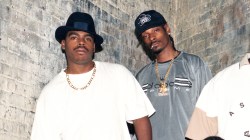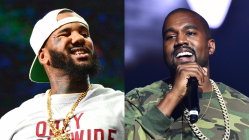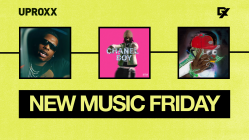On April 17, 1990, A Tribe Called Quest dropped their classic debut album People’s Instinctive Travels And The Paths Of Rhythm. They took MTV by storm and immediately made a name for themselves with “I Left My Wallet in El Segundo” and “Bonita Applebum.” Also worth noting is their early ascension, subsequent to the rises of De La Soul and Gang Starr. Of course, The Beastie Boys, Run DMC, and N.W.A. had already attained varying levels of International stardom. Rap groups were all the rage, and rather than being deterred by the landscape, Tribe saw an opportunity.
In my opinion, the most important outlier pertaining to Tribe and the aforementioned groups, is their specificity to the Golden Era. So, not coincidentally, I also think the deaths of Tupac and Biggie can be directly correlated with declining Rap group formations since the ‘90s. Today, the focus is about being Michael Jordan, not the ‘96 Chicago Bulls.
The Return Of The Hip Hop Group
Through popular discourse, though, Rap groups have become something to talk about again. Chris Rock’s 2014 movie Top Five still has everyone and their mothers wanting to share their five favorite rappers. In the film, Rock’s list is comprised of individual artists, while Rosario Dawson has a few groups including Salt-N-Pepa taking up top tier real estate.
You won’t find any groups in my top five; from a logistical standpoint, it seems problematic to rank a multi-member group against an individual. Then again, that may be misstated. Top Five forced the rap-listening public to juxtapose solo artists with groups, begging the question, “Where are all the rap groups today?” Furthermore, I think the imminent release of Straight Outta Compton should continue to stoke those flames.
So, will there ever be another Tribe? My gut tells me no, not in the traditional sense. Not for any reason having to do with ‘Pac, B.I.G., or the Golden Era. But, more specifically, because of how the group dynamic has changed since Peoples Instinctive Travels.
The status quo for contemporary groups is now the indie label collective. Odd Future and Funk Volume are not groups, but in my opinion, Odd Future specifically embodies the evolution of Rap groups. Many have called their business model similar to the Wu-Tang Clan’s: Wu was signed as a group to Steve Rifkind’s Loud Records, but their individual solo projects could be released on other labels. In 1994, Method Man dropped Tical via Def Jam/Polygram, and a year later, GZA released Liquid Swords through Geffen/MCA.
The Rise Of Odd Future As The New Wu-Tang… Kind Of
Fast-forward 20 years, and OFWGKTA follows a very similar blueprint. The Odd Future label-compilations are produced and released on their own imprint, while Earl Sweatshirt just dropped I Don’t Like Shit, I Don’t Go Outside: An Album By Earl Sweatshirt via Tan Cressida/Columbia. Earl is still a member of Odd Future, but his business ventures are done according to his own interests.
It’s important to note that from its inception, Odd Future was a brand first and foremost. According to Drew Tewksbury of Los Angeles Magazine:
“The label was a departure point with each act developing its own narrative, aesthetic, and sound. Each member was an individual entrepreneur but they were unified under the Odd Future umbrella. Syd was the sensitive one, whose home studio was where the crew would often lay down tracks. Tyler was the maniacal genius who could spout off controversial tweets one minute and work with superstar pop-surrealist painter Mark Ryden the next. Earl was the mysterious one, who disappeared (his family sent him to military school in the Samoa) then reappeared with a devout following.”
Their structures may be similar on paper, but in my opinion, business is the only commonality between Wu-Tang and Odd Future: Wu-Tang Clan is a group, conceived by the RZA with nine original members. They put out six albums in the span of 20 years. Odd Future is a collective of like-minded individuals with personal agendas. Their label-compilations contain one or two tracks by each artist on the roster. They must not be confused with a group that considers themselves one single entity moving as a single organism. Rather, I think they’re more representative of smaller imprint cliques, a´la the Ruff Ryders during the Ryde or Die days.
Odd Future, Jamla and Top Dawg, among others, have alleviated some artists’ concerns about moving as a unit. When said label mates collaborate, it transports the listener to a musical realm achievable only through the traditional group dynamic that A Tribe Called Quest championed. This particular experience remains conspicuous in its absence.
Going Solo & The Ying/Yang Of Phife Dawg With Q-Tip
Aspiring artists have many reasons to prefer the solo endeavor. For one, it’s just easier. There isn’t a dependence on others to stay within the same creative realm at all times. But I also think the bulk of the answer resonates on a more metaphysical level.
During the peak of the Golden Era, Hip Hop groups were all the rage and came in numbers, whether it was a producer and emcee (Eric B. & Rakim), a trio (De La Soul) or a larger pack of associates (N.W.A.); collective individuals working as one unit. Yet for all of the success stories, fans and consumers today remain prone to picking favorites and/or the “best” member. I don’t think listeners should be at fault for having this tendency; it’s just Murphy’s Law.
Tribe made a name for themselves because they were protean conveyors of both a sound and a movement, but also because all three members had style. It was Ali Shaheed on the 1s and 2s, with Q-Tip, a/k/a Kamal The Abstract, and Phife Dawg the Five Foot Assassin. On their respective solo endeavors after The Love Movement, Q-Tip achieved more commercial success than Phife: Amplified (1999) was certified Gold, while Ventilation: Da LP (2000) flew under the radar. But I don’t have to tell you that every rapper knows sales aren’t everything when assessing talent.
In Michael Rapaport’s documentary Beats, Rhymes & Life: The Travels of A Tribe Called Quest, Ali Shaheed notes that “In making The Low End Theory, I definitely think there’s, you know, what’s evident to everyone, and that’s the emergence of Phife Diggy Dawg.” Likewise, Questlove, Pharrell Williams and the Beastie Boys all commend Phife’s performance in particular, with Questlove commenting, “Tip is very smooth, Phife is very high. The yin and yang of those two, that to me was the perfect marriage.”
Yet for all of Phife’s growth between Peoples Instinctive Travels and The Low End Theory, Q-Tip always overshadowed him. According to the famed Hip Hop executive and Tribe confidant Chris Lighty, Q-Tip was the master savant:
“Sometimes the creativity becomes a block, because we literally had to go in and take The Low End Theory album from him…He could have been like Guns N Roses. Seven years later, Midnight Marauders comes out. He could have been that guy. He could be Axl Rose and Dr. Dre if you let him. He’s that creative.”
Q-Tip may have better name recognition and popularity next to the other Tribesmen, but he also knows he couldn’t have achieved all that he has without the help of Phife and Ali Shaheed. Nevertheless, his artistic identity was — and for many still is — the paradigm of A Tribe Called Quest. His prowess and meticulousness worked at odds with Phife’s vision, and their differences, coupled with executive concerns, enabled the demise of Tribe.
Migos & The New Hip Hop Group
Earlier, I referred to the sparse formations of Rap groups after Tupac and Biggie died. In the early 2000s, Clipse and Little Brother were dope, but they split. On the other hand, we still have Atmosphere, Dilated Peoples, CunninLynguists, and People Under The Stairs among others. Save for Dilated People’s moment in the sun with Kanye on “This Way,” mainstream success hasn’t come easy for groups of the new millenium. There is one exception though.
The South is the last frontier for Rap groups. They’ve fostered the successes of several acts over a span of decades, from the Geto Boys to Migos. In fact, Migos is making a name for themselves as the definitive hot new Rap group. Detractors point to their trademark triplet flows as bitten from those that came before them; Bone Thugs-n-Harmony and Three 6 Mafia come to mind as architects of the sound. But I think Migos’ current success is a testament to the culture of inclusion typified by Southern Hip Hop. That very culture of inclusion is also reminiscent of New York during the Golden Era.
Speaking about their track “New Atlanta” with HipHopDX’s Ural Garrett in October 2014, Migos addressed Atlanta’s current Hip Hop dominance, with Offset noting, “I see us paving waves for other groups and I see new groups coming out right now. You see Rae Sremmurd, they’re based out of Atlanta and they go hard. We’re bringing groups back as young bosses.”
Offset isn’t incorrect. Rae Sremmurd is on the uptrend, while Migos recently tore up SXSW and continues leaving their mark every which way they go. They’re trail blazing the way for Atlanta artists, and groups in particular.
Migos did not originate their sound, but it comes from a long line of groups before them. Last year, Complex traced the lineage of Migos’ flow, and the triplet delivery has been so oft utilized over the years that dozens of artists have made it their bread and butter. Migos falls into a long line of groups that use it as a signature identifier. As a shared building block, triplet flows have enabled the successes of groups (Three 6 Mafia) and individual artists alike. It is the baton that has been passed on and on.
Tribe doesn’t share the triplet flow, nor did they ever partake in any concrete regional lyrical themes. Interconnecting verses (“Check The Rhyme”) come to mind, but that was never unique to any one particular group. Nevertheless, the groups of the Golden Era represented a similar culture of inclusion to that of the South. In my opinion, the fact that there has never been a definitive King of the South is relevant to roles of triplet deliveries and countless group success stories in Southern Hip Hop.
The Endurance Of A Tribe Called Quest
A Tribe Called Quest was so successful because at their peak they achieved a wonderful yin and yang with each other. Q-Tip remains widely regarded as the most prolific member, yet plenty of fans still love Phife. I don’t think we’ll ever see another Tribe because that’s not how the cards are currently stacked. The group dynamic has evolved, and Indie label collectives are the new quote unquote groups. Each artist can pursue individual greatness, while still shining with his or her peers. The labels act as brand umbrellas; the artists fit underneath.
At the same token, Migos is a case-and-point example of a Rap group in the traditional sense. But I see them partially as a product of Three 6 Mafia and Bone Thugs-N-Harmony, which is by no means a bad thing. Triplet flows have been in the bloodline of many Hip Hop groups along the way. Migos is merely providing their own variation, inspired by the groups they grew up listening to.
The prospects of an original new Rap group emerging are slim. However, the predominating phenomenon of Indie label collectives, and the foundation already in place in the South will continue to enable updated dynamics and formulas of traditional group structures.





![50 Cent Shares Unseen Diddy Footage From Netflix Documentary: "[It] Shows You His Character"](https://hiphopdx.com/wp-content/uploads/2025/12/50-cent-diddy-documentary-trailer-unseen-footage.jpg?w=250)




Solid write up but you’re a week late. The album came out on April 10th, 1990.
“So, will there ever be another Tribe? My gut tells me no…”
My gut tells me your gut ain’t heard March on Washington by Diamond District… otherwise you’d tell your gut to shut the fuck up.
Oddisee was a solo artist pre Diamond District. Thanks for playing.
Just a comment, not a game son… & MMG sux too.
Check out my group were from the South just google prolegend